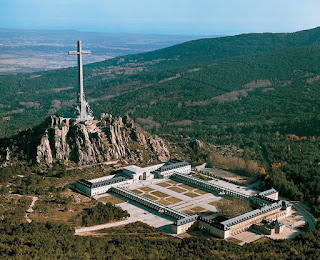Sarcophagus (pronounced sahr-kof-uh-guhs)
(1) A stone coffin, especially one bearing sculpture, inscriptions, etc, often displayed as a monument.
(2) In Ancient Greece, a kind of limestone thought to consume the flesh of corpses, used for coffins.
(3) In contemporary use, any (usually large) structure used to encase something.
(4) A form of wine cooler used in the eighteenth century.
1595-1605:
From the French sarcophage, from the Latin
sarcophagus, from the Ancient Greek
σαρκοφάγος (sarkophágos) (coffin of
limestone), noun use of the adjective sarcophagous. The original in Ancient Greek was so named because
of the limestone’s supposed property of consuming the flesh of corpses laid in
it: σαρκοφάγος (sarkophágos) (flesh-eating,
carnivorous), from the genitive σαρκός (sarkós)
of σάρξ (sárx) (flesh; meat) + -φάγος
(-phágos) (from ἔφαγον
(éphagon), past of φάγω (phágō) (eat), the root of phagein (to eat) being the
primitive Indo-European bhag- (to share out, apportion; to get a share). The preferred plural remains sarcophagi
although all dictionaries list the unpalatable sarcophaguses as an alternative.
In
English, the sense "stone" was the earliest, the meaning "stone
coffin, often with inscriptions or decorative carvings" didn’t emerge
until 1705. The Classical Latin was shortened in Vulgar Latin to sarcus, source
of the French cercueil (coffin, casket), the German Sarg (coffin) and the Dutch
zerk (tombstone). The reputation of lime
as a means of causing the rapid putrefaction of corpses persisted well into the
twentieth century and was the downfall of some murderers subsequently surprised
to learn it acted instead as a preservative on the bodies they had buried.
The
Chernobyl incident
The incident at the Chernobyl power-plant on 26 April 1986 was trigged by an uncontrolled nuclear chain reaction which happened because of a series of events over two days, ironically during was supposed to be a test of safety systems. After several explosions, during which quantities of radioactive material were released and spread widely over Europe, the core of reactor number four melted down. Despite this, other reactors continued to operate and the Chernobyl power plant wasn’t finally decommissioned until December 2000. The surrounding area is now an exclusion zone and will not be habitable for at least twenty-thousand years with the highly contaminated reactor number four encased in what was intended to be only a temporary concrete sarcophagus (the original Russian name was Объект Укрытие (Obyekt Ukrytiye) which translates as sheltering or covering); it’s since been covered with a metal enclosure.
After incidentThe contaminated ruins of reactor number four were so dangerous that work on a sarcophagus began within a month of the meltdown, construction of the reinforced concrete structure substantially complete by November 1986. However, the building had become so radioactive it became impossible for workers to approach close enough to finish the work and the robots used instead were not able completely to seal the sarcophagus.
Sarcophagus
Envisaged by engineers to have a life of thirty years, the sarcophagus deteriorated more quickly than had been expected and in 1997 an international project was formed to design and build something more durable. Known as New Safe Confinement, it is a metal arch some 344 feet (105 metres) high and spanning 843 feet (257 metres), prefabricated and moved on rail lines, sliding over the existing sarcophagus. The project team noted the adoption of the word confinement, rather than containment, commonly used in nuclear facility architecture. The distinction is the difference between a reactor containment building which designed to contain radioactive gases and a structure built for the confinement of solid radioactive waste.
New Safe Confinement
Construction was completed in late 2018, after which trials and tests of the internal systems were run. Unlike the sarcophagus, New Safe Confinement is designed to permit, using robotic devices, the remains of reactor number four safely to be dismantled and removed. This is of course a man-made structure and like them all, nothing lasts forever and there is still no agreement between engineers about when a replacement layer will have to be added although all agree the new sarcophagus should adequately serve for decades; the discussion is about how many.










